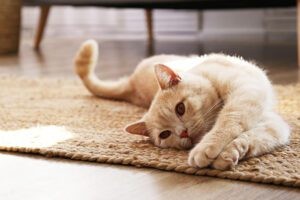Ever noticed your cat making a sound that’s unlike a typical meow or purr? This unique vocalization, often described as a soft chirp or roll, is called trilling. Understanding why cats trill opens a window into their communication and emotions. Let’s explore the fascinating world of cat trilling to understand what your feline friend is trying to tell you.
 cat looking upwards
cat looking upwards
What Exactly IS Cat Trilling?
Cat trilling is a distinctive sound, a type of vocalization that falls somewhere between a meow and a purr. It’s characterized by a soft, rolling, chirruping noise. This sound is produced through a unique movement of the mouth and vocal cords. Unlike meows, which are often reserved for communicating with humans, cats typically use trills when interacting with other cats, animals in their environment, and even their beloved human companions in a friendly and affectionate manner.
Think of it as a gentle, almost bird-like chirp emanating from your feline. This charming sound is a key part of feline communication, expressing a range of emotions and intentions. When your cat trills at you, it’s more than just a random noise; it’s a deliberate attempt to engage with you, conveying various messages from simple greetings to requests for attention.
The Purr-poses of Trilling: Why Cats Do It
Cats trill for a variety of reasons, each providing insights into their mood, needs, and even their instincts. Deciphering these reasons enhances your connection with your cat and allows you to respond appropriately to their signals.
Expressing Joy and Affection
One of the most heartwarming reasons behind cat trilling is the expression of happiness and contentment. When your cat greets you with a trill, consider it a vocal hug. It’s a clear indication of affection and a joyful “hello,” signifying they are pleased to see you. This happy chirping often accompanies other positive cat behaviors like rubbing against your legs or a relaxed posture.
Seeking Attention and Needs
Cats are masters of communication, and trilling is one of their subtle yet effective methods to get your attention. They might trill to signal various needs, from a gentle nudge for playtime to a more direct hint that their food bowl is looking a little empty. This behavior demonstrates their comfort in communicating their desires to you, relying on this charming sound to draw your focus.
Maternal Instincts: Mother-Kitten Calls
The trill plays a vital role in the communication between mother cats and their kittens. Mother cats utilize trilling sounds to guide their kittens, call them back to safety, or simply keep in contact. It’s a nurturing vocalization that strengthens the bond between a mother cat and her young offspring, starting from their earliest interactions. This instinctual behavior highlights the deep-rooted nature of trilling in feline communication.
Playfulness and Exploration
Sometimes, a cat’s trill is an invitation to engage, either in play or exploration. It can be an expression of their playful spirit and curiosity about their surroundings. A trill in this context might be accompanied by playful postures, like a crouched stance ready to pounce, or directed towards a toy or an interesting object in their environment. It’s their way of verbally expressing their desire to interact and explore the world around them.
Listen Up! How to Respond to Cat Trills
Understanding the reasons behind your cat’s trilling is only half the equation. Knowing how to respond appropriately is crucial for strengthening your bond and fostering effective communication with your feline companion.
Engage and Interact
When your cat trills in a playful or attention-seeking manner, the best response is to engage with them. Initiate playtime with their favorite toy, offer gentle petting, or simply spend quality time cuddling. Responding positively to their trills reinforces this form of communication and shows your cat that you understand and appreciate their attempts to interact with you.
Fulfill Needs (When Appropriate)
If the trilling seems to be a request for food, assess the situation. If it’s mealtime, or if they genuinely seem hungry, provide them with food. Similarly, if they are trilling near a toy, it’s likely an invitation to play. Responding to these needs, when appropriate, reinforces positive communication. However, be mindful of not overfeeding your cat or always giving treats in response to trilling, to maintain a healthy balance.
Emotional Attunement
Sometimes, trilling can indicate deeper emotional needs. Your cat might be trilling to seek comfort, reassurance, or simply to feel more secure. In these instances, a comforting presence, gentle words, and a soothing touch can be incredibly effective. Being attuned to these emotional nuances in their trills helps your cat feel loved, secure, and understood.
When Trills Tell a Different Tale: Health Concerns
While trilling is generally a positive and normal feline vocalization, significant changes in your cat’s trilling habits can sometimes signal underlying health issues. It’s crucial to be observant of any alterations in their usual patterns.
If you notice a sudden increase or decrease in trilling, or if the trilling is accompanied by other concerning symptoms such as lethargy, loss of appetite, or changes in behavior, it’s important to consult with a veterinarian. These changes could indicate discomfort, pain, or an underlying medical condition that requires professional attention. Paying attention to the context and accompanying behaviors will help you discern whether the trilling is a normal expression or a potential sign of a health concern.
Understanding your cat’s trilling is a wonderful way to deepen your relationship and respond to their needs more effectively. By paying close attention to these chirping sounds and the context in which they occur, you unlock a richer, more rewarding connection with your feline friend, enhancing your shared life together.